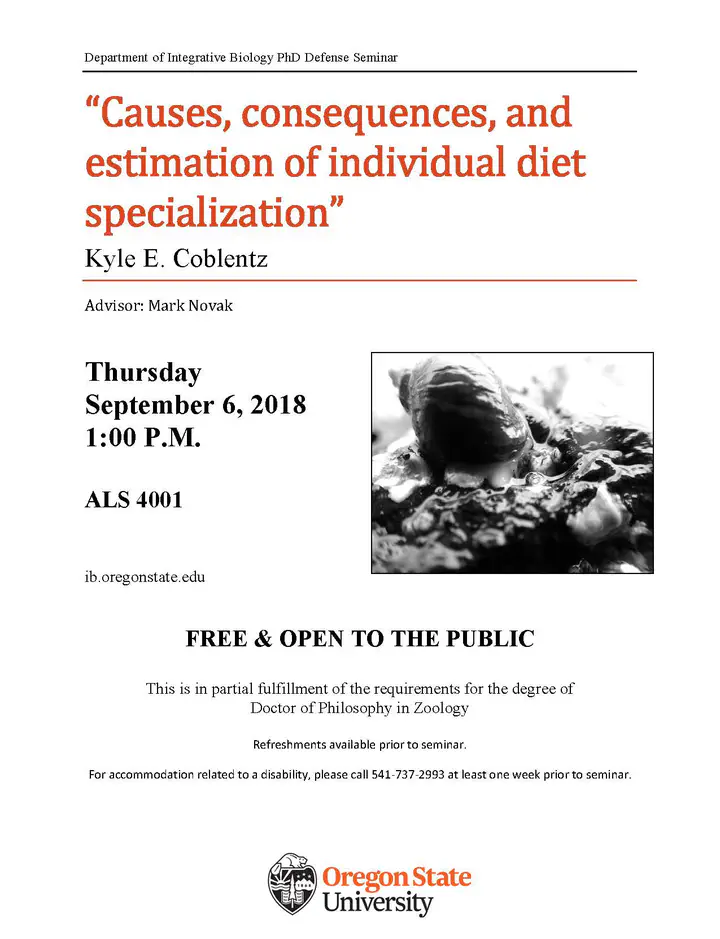
Abstract
Diet variation among individuals within populations is widespread. Often diet dierences among individuals are attributable to obvious differences among individuals such as age, sex, or morphology. However, growing evidence suggests that individual diet variation is also common among seemingly identical individuals within populations. This phenomenon has been termed individual diet specialization. Individual diet specialization has been documented across a variety of taxa and biomes and theory suggests that diet specialization can potentially alter the structure and strength of predator-prey interactions. This raises two important questions: 1) What are the causes of individual diet specialization?, and 2) What are the potential consequences of diet specialization for populations and communities? In this dissertation, I attempt to address these two questions by combining mathematical theory, the novel application of statistical methods, and field and laboratory experiments with the intertidal whelk, Nucella ostrina.
A potential ultimate cause of variation among individuals is disruptive selection in which natural selection favors individuals with more extreme trait values over individuals with intermediate trait values. Theory has suggested that the availability of alternative resources and intraspecific competition for those resources can drive disruptive selection in consumers and lead to increased diet variation. However, this theory makes several ecologically unrealistic assumptions. In particular, this theory assumes that consumers have linear functional responses and that the trait of the consumer under selection only influences the consumer’s attack rates on resources. In Chapter 2, I alleviate these assumptions and show that nonlinear functional responses and traits influencing multiple functional response parameters simultaneously can influence the strength and likelihood of disruptive selection. My results suggest the characteristics of consumers in which disrup- tive selection in resource-use traits may occur and diet specialization through this mechanism may be most likely.
To empirically evaluate hypotheses on the causes and consequences of individ- ual diet specialization, we need to be able to accurately quantify diet specialization. In Chapter 3, I apply Bayesian hierarchical models to the problem of estimating diet specialization and compare the performance of the Bayesian hierarchical models to currently used methods for estimating diet specialization. Currently used methods infer individual prey preferences using the observed proportion of prey in individuals’ diets whereas the Bayesian hierarchical models instead estimate these proportions. I find that the currently used approach tends to overestimate diet specialization compared to the Bayesian hierarchical approach. This is especially the case when sample sizes per individual are low or heterogeneous. In addition, the Bayesian hierarchical approach provides estimates of prey proportions, their variability, and the uncertainty on these estimates in ways that are inaccessible to current methods. These results suggest that the Bayesian hierarchical method can provide an improved method for quantifying diet specialization.
In Chapter 4, I present the results from a field caging experiment examining the proximate ecological mechanisms determining individual diet specialization and its consequences in the intertidal whelk, Nucella ostrina. Many of the hypotheses on the ecological causes of diet specialization assume that individuals differ from one another in their prey preferences. However, these hypotheses ignore the potential influence of stochasticity in the foraging process in generating diet variation among individuals. The results of this chapter suggest that changes in the magnitude of diet variation with changes in prey community composition in Nucella ostrina can largely be explained by stochastic foraging by individuals with shared prey pref- erences. In this chapter, I also estimate the consequences of this diet variation for estimates of predator feeding rates through nonlinear averaging (Jensen’s inequality) of predator attack rates. The results suggest that nonlinear averaging alters the perceived strength of predator-prey interactions in this system providing one of the first empirical estimates of the potential consequences of diet variation.
Overall, my dissertation provides several insights into the potential causes of diet specialization, provides one of the first empirical estimates of a possibly widespread consequence of diet specialization for populations and communities, and suggests improved statistical methodology for quantifying diet specialization. I believe that this dissertation will lead to a critical assessment of definitions of individual diet specialization, provide guidance towards systems in which diet specialization is the most likely to occur, and encourage further empirical research estimating the e↵ects of diet specialization on populations and communities.